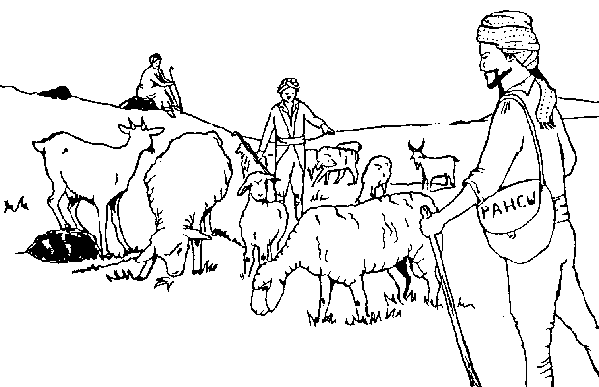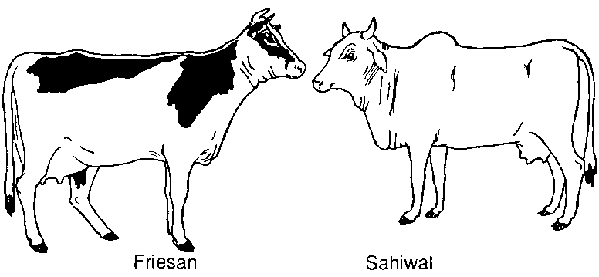Unit 1: Why do we keep animals?
Unit 2: Animals and the environment
|
We keep animals to provide us with: · meat Some animals are used for transport, ploughing and work. |
Learning objectives
After studying this unit you should:
1 Know what animals are kept in your community.
2 Know what the animals are used for.
3 Find out if the animals in your community or village are good and healthy.
What animals are kept in your community?
If you want to be a good Primary Animal Health Care Worker (PAHCW) it is very important for you to know what animals are kept by the people in your community. You must know your community very well and discover who keeps animals and what type of animals they keep. You must work with all of the community's livestock.
What are the animals used for?
What does your community keep its animals for? Are the animals kept for meat or for work? Do they provide you with milk? What other things do you get from the livestock you keep?
If you keep animals for meat do you kill the young or the old animal for meat? Does your community keep some animals only for work or for meat, to give milk, or for other reasons? Try to find out as much as you can about the use of animals in your community.
How good are your animals?
Are your animals providing you with enough milk or meat? Are your livestock better than those of neighbouring communities or regions? How do your animals differ from those in neighbouring communities?
Communities in neighbouring regions can keep different types of animals. For example cows in one region can produce more milk or give better meat than those in another region. You should consider your livestock and compare them to those of your neighbouring communities. Talk to people from other communities or to other Primary Animal Health Care Workers.
You may already know of some health problems in your community's livestock. If you talk to others in the community you may find out about other animal health problems. There may be particular problems related to certain breeds or types and not others. Some of the health problems you may discover are:
· Animals die suddenly.
· Young animals are born sick or dead.
· Leg and foot problems.
· Skin troubles.
· Animals do not increase in weight.
· Livestock suffer from worms, ticks or lice.
· The udders of milk animals become swollen and blood is found in the milk.
· Chickens stop laying eggs or die suddenly.
There can be very many health problems. You should talk to the people in your community to discover the various problems they have with the health of their animals, but also try to discover what are the problems in neighbouring communities. You may find that you have the same problems or you will gain knowledge which will help you prevent a health problem reaching your community's livestock.
You must keep good contacts with your nearest veterinarian and livestock specialist. Remember that these people are there to help you.
Keep an animal health record for your community
It will help you to succeed as a Primary Animal Health Care Worker if you keep a record of the health and other problems of your community's livestock.
Make a record of who keeps the various animals. Discover and make note of the problems that they have. Talk to the owner of the animals and discover if the problems are related to a particular time of the year or season, changes in food or water supply, movement of livestock or the introduction of new animals to the herd (see Annex 5).
Keep an animal health record for your community

|
The environment is whet you find around you. The plants, water, soil and climate are all part of your environment. Man keeps animals which are suited to his needs and his environment. There is a limit to the number of animals which we can keep in any area. If we ignore these facts we can have management and health problems in our livestock and damage to the local environment. |
Learning objectives
After studying this unit you should know:
1 The problems which can result from keeping too many animals.
2 If the animals you keep are suited to your environment and your needs.
3 The different breeds (types) of animals kept in your community.
4 Any areas of the community's land which have been damaged by animals.
Different breeds (types) of animal
Throughout the world man keeps animals which are suited to the local environment. Feed, water and climate are the main factors which determine what animals are in any one region. As a result of this we find a large variety of animal breeds throughout the world.
· In England sheep have thick woolly fleeces to protect them against cold winters. In Somalia, where the climate is very hot, the sheep have light, hairy coats
Sheep (English - Somali)

· Friesian cows produce a lot of milk on the good grasslands in countries with cool weather conditions. In India the Sahiwal cattle are good milk producers in the hot tropics.
Cows (Friesan - Sahiwal)

· In China pigs are fed on food which is mainly roughage and so developed a pot-belly to use this type of food. In Europe pigs are fed a lot of grain and have leaner bodies.
Chinese pot belly pig - European pig
Remember that the livestock in your community developed over a long time. They are accustomed to your environment.
Sometimes people want to introduce new breeds to an area. This must be carefully considered and advice taken from knowledgeable persons as the new breeds may not be suited to the new environment.
The number of animals kept in the community
We should not keep animals which are old or barren as they will eat the feed that could be better used for young animals.
You should consider the number of animals kept in your community. Is enough feed and water available for them all year? Discuss with your community elders and leaders any problems you may discover in the numbers of animals and the available feed and water. Controlling and planning livestock numbers and the availability of good feed and water is basic to primary animal health care.
Problems of overstocking (too many animals)
If we do not keep the numbers of livestock in relation to available feed and water then:
· Animals lose weight, become sick and disease spreads.
· Animals do not breed well and death of young occurs.
· Overgrazing and loss of pasture, bushes and trees occur.
· Loss of vegetation will result in erosion of soil and loss of good land.
Talk to the elders in your community and discover what changes there have been in the environment and what may have caused them. Can the situation be improved?